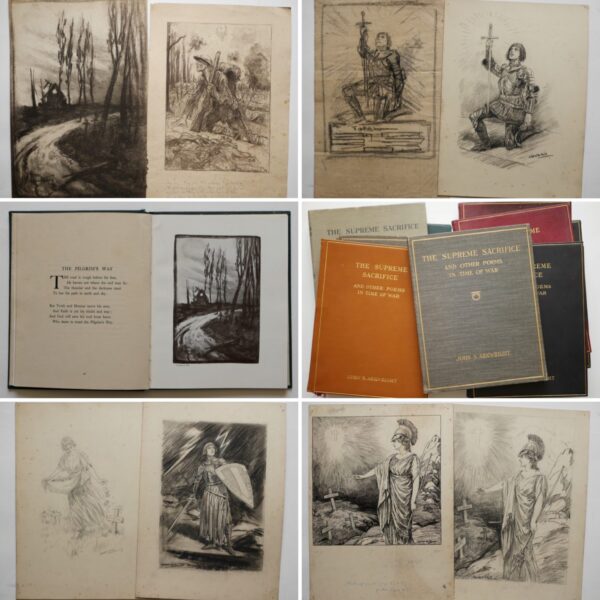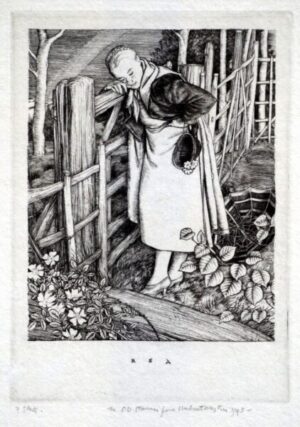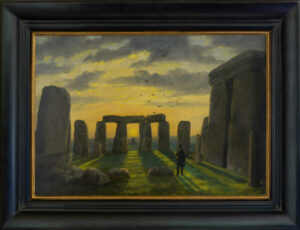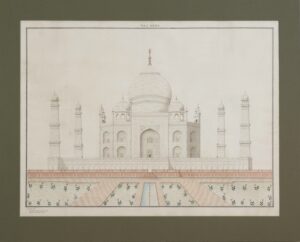Description
The First World War poster ‘Missing!’ (Not included in the sale) relates to his poem of that title in The Supreme Sacrifice, (p.22) written in memory of Red Cross Nurses drowned at sea, with facing illustration that closely resembles the poster.
Sir John Stanhope Arkwright (1872-1954, known to the family as ‘Jack’) inherited Hampton Court estate from his father in 1905. By then the estate was encumbered with mortgages, but once he had cleared those and settled death duties, he put the estate up for sale and moved to Kinsham Court.
In 1900, he was a Barrister, but had also been private secretary to the Home Secretary, Sir Matthew White Ridley, and he became the popular Conservative candidate for Hereford, being described as a fluent speaker and a great lover of cricket and football. John was duly elected later that year but in 1912 he resigned due to ill health, and an impending operation.
He was educated at Eton and Christ Church Oxford. In 1895 he won the Newdigate prize for English Poetry for his epic ‘Montezuma’. (His own verdict, confided to his mother, was “not at all satisfied with it & am doubtful about sending it in. I think it is just above the average of a bad year.”) He published a volume of poetry The Last Muster (1901) in response to the Boer War which drew a favourable response from Rudyard Kipling. However, it is for his Great War hymn, ‘O Valiant Hearts’ first sung on 5th August 1917 at Westminster Abbey to mark the anniversary of the outbreak of war, that he is best remembered.
His words were sung at the burial of the Unknown Soldier, at the dedication of the burial flag of Ypres, and at the consecration of the Houses of Parliament and Menin Gate war memorials. They were also recited by the Premier of Canada over the transatlantic telephone at the unveiling of the Canadian memorial at Vimy Ridge. The tune is still played annually at the Cenotaph in London at the Remembrance Sunday service. He was described as the ‘inspired interpreter of the nation’s deep and inmost feelings’. He was Knighted in the 1934 New Year’s honours list.
He spent some years at Kinsham Court and in 1934 he was a awarded a Knighthood, following which he was presented with the freedom of the City of Hereford, it being reported in the Hereford Times: “Sir John Stanhope Arkwright of Kinsham Court, Co. Hereford, author of the hymn O Valiant Hearts, was on Saturday presented with the freedom of the City of Hereford. He is the brother of Mrs. Chester-Master, widow of Major R.C. Chester-Master, D.S.O., K.R.R.C., Chief Constable of Gloucestershire, who was killed in Action in 1917”.
He died in Presteigne on 19th September 1954
Brand
Bairnsfather, Bruce (1888-1959)
Captain Bruce Bairnsfather became world-famous during the First World War as creator of Old Bill, the walrus moustached old soldier who appeared in many of his “ Fragments from France” cartoons depicting life at the Front. Published weekly in “The Bystander” magazine from 1915 they caught the imagination of both the men on the front line, and their families back home. Bairnsfather became a household name and published volumes of his cartoons sold over a million copies. In 1916 he was transferred to the Intelligence Department of the War Office, and officially appointed “Officer Cartoonist,” touring the French, Italian and American armies in this capacity.
But Bairnsfather was much more than a cartoonist, and in a career lasting over forty years was involved in a great many fields of entertainment. He was an accomplished author, playwright and lecturer, and in 1927 spent a year in Canada, directing a major motion picture, for which he had also written the screenplay. He appeared on the vaudeville stage in America, and in variety in England. In the 1920’s he was one of the first celebrities to be recorded talking on film in America, and a decade later took part in the early television broadcasts from Alexandra Palace.
Between 1920 and 1950 Bairnsfather undertook eleven lecture tours of America and Canada. He lived almost permanently in New York from 1926 to 1932 and worked for many well-known American publications such as “ Life”, “ The New Yorker”, and “ Judge”.
In the 1930’s he contributed to popular English magazines such as “ The Passing Show”, “ Illustrated”, “ John Bull” and the “ British Legion Journal”. With the outbreak of the Second World War, he introduced Old Bill’s son, Young Bill, and a film was made about the pair—”Old Bill & Son.”
From 1942 to 1944 he was officially attached to the American Forces in Europe, firstly with the American Army in Northern Ireland, and then the USAF at Chelveston in the UK, where he was based 1943 to 1944.
Captain Bruce Bairnsfather once described as “The Man who Won the War” and “the world’s greatest cartoonist” died on 29th September 1959 at the age of 72. In a career lasting forty-five years he had done an enormous number of different things, almost always accompanied by Old Bill, and almost sixty years after his death still has a large following among enthusiasts and collectors worldwide.
Raemaekers, Louis (1869-1956)
Louis Raemaekers was born in Roermond in the Netherlands. Louis’ father published a weekly journal called De Volksvriend (Friend of the People) and was an influential man in liberal circles. His mother was of German descent. He was trained and later working as a drawing teacher made landscapes and children’s books covers and illustrations in his free time. In 1906 his life took a decisive turn when he accepted the invitation to draw political cartoons for leading Dutch newspapers, first from 1906 till 1909 for the “Algemeen Handelsblad” and from 1909 onwards for “De Telegraaf”.
During The First World War Louis Raemaekers became one of the Germans fiercest critics. His message was clear: the Netherlands had to take sides for the Allies and abandon its neutral stance. His graphic cartoons depicted the rule of the German military in Belgium, portrayed the Germans as barbarians and Kaiser Wilhelm II as an ally of Satan. His work was confiscated on several occasions by the Dutch government, and he was criticized by many for endangering the Dutch neutrality. The minister of Foreign Affairs John Loudon invited Raemaekers, the owner of De Telegraaf H.M.C. Holdert and the editor-in-chief Kick Schröder under pressure from the German government to a meeting, at which he requested them to avoid ‘anything that tends towards insulting the German Kaiser and the German army’. It was not possible to prosecute Raemaekers for as long as the country was not under martial law. But the pressure on him continued, also from Germany: in September 1915 the rumor even started circulating that the German government had offered a reward of 12,000 guilders for Raemaekers, dead or alive, but proof of an official statement has never been found.
Louis Raemaekers achieved his greatest successes outside his native country. He left for London in November 1915, where his work was exhibited in the Fine Art Society on Bond Street. It was received with much acclaim. Raemaekers became an instant celebrity, and his drawings were the talk of the town: ‘they formed the subject of pulpit addresses, and for two months, the galleries where they have been exhibited have been thronged to excess. Practically every cartoon has been purchased at considerable prices.’ He decided to settle in England and his family followed in early 1916. His leaving the Netherlands for London was a godsend for all concerned. Henceforth, the Dutch government could distance itself from the cartoonist and his work in its diplomatic relations, thus stabilising its position vis-à-vis Germany, while Raemaekers himself could cease his hopeless campaign to get the Netherlands to abandon its neutral stance. He may also have realised for himself that his aim of persuading his country to take up arms and thus avoid the fate of Belgium was not very realistic. From early 1915 Raemaekers' cartoons had already appeared in British newspapers and magazines. In early 1916 he signed a contract with the Daily Mail and they appeared in this newspaper on a regular basis for the next two years.
Following the end of the First World War, Louis Raemaekers settled in Brussels. He became an advocate of the League of Nations and devoted many sketches and articles to the cause of unity in Europe.
Shortly before the start of the Second World War Raemakers fled to the United States and remained there until 1946, when he returned to Brussels. He died in Scheveningen near The Hague in 1956.
Raven-Hill, Leonard (1867-1942)
Leonard Raven-Hill, the son of a stationer, was born in Bath on 10th March, 1867. He was educated at Bristol Grammar School and the Lambeth School of Art, where a fellow student was F. W. Townsend. He then moved to Paris until being appointed as art editor of Pick-Me-Up. On his return to London he worked as a painter and exhibited at the Royal Academy.
Raven-Hill's drawings first began to appear in Punch Magazine in December, 1895. By 1901 Raven-Hill had joined the staff of the magazine where he succeeded Linley Sambourne as junior political cartoonist under Bernard Partridge. During this period he also illustrated Stalky and Co for Rudyard Kipling and Kipps for H. G. Wells.
Unlike most of the cartoonists at Punch Magazine Raven-Hill was fairly sympathetic to liberal causes such as women's suffrage and David Lloyd George when as Chancellor of the Exchequer in the 1906-1914 government attempted to introduce measures such as old age pensions and National Insurance.
Raven-Hill was a strong advocate of British Imperialism, and like his main colleague at Punch Magazine, Bernard Partridge, was a strong supporter of the Conservative Party. During the First World War he produced posters encouraging men to join the armed forces.
After the war he worked for a wide variety of newspapers and magazines including The Daily Graphic, Daily Chronicle, The Strand Magazine, The Sketch, The Pall Mall Gazette and The Windsor Magazine. It has been argued that his failing eyesight made most of his later work disappointing. However, he continued to comment on life in Nazi Germany and the outbreak of the Second World War.
Leonard Raven-Hill died at Ryde, Isle of Wight, on 31st March, 1942.



